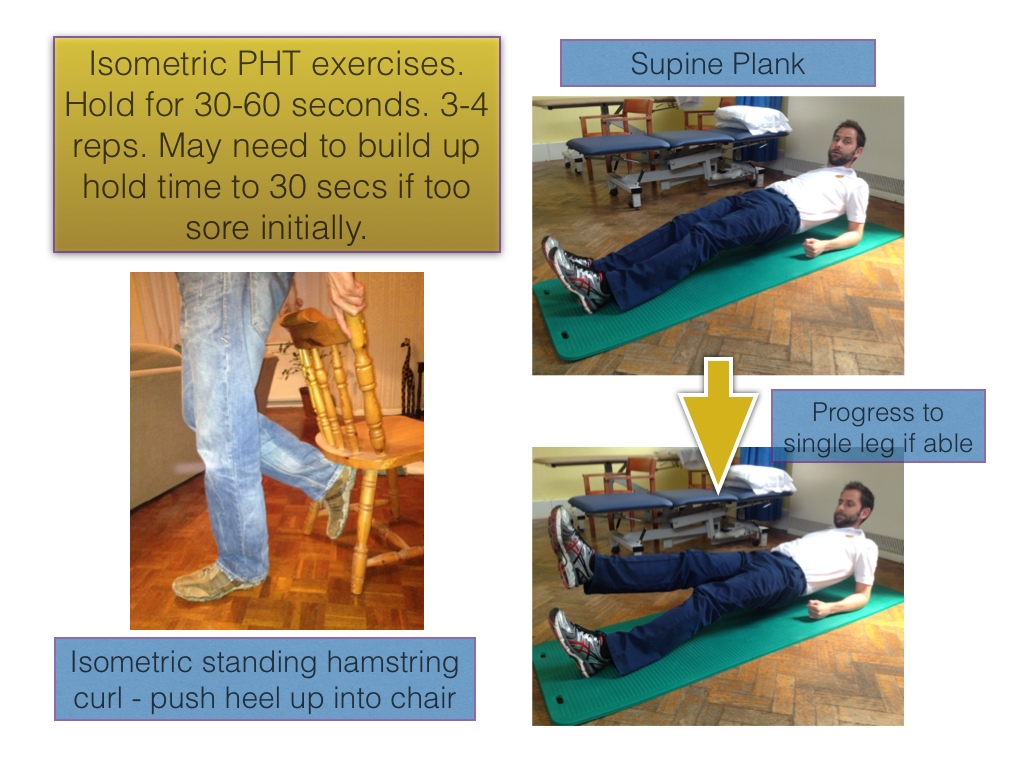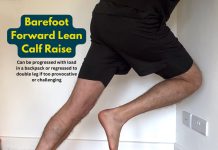Our articles are not designed to replace medical advice. If you have an injury we recommend seeing a qualified health professional. To book an appointment with Tom Goom (AKA ‘The Running Physio’) visit our clinic page. We offer both in-person assessments and online consultations.
Back in February, I developed a nasty reactive Proximal Hamstring Tendinopathy (PHT). That pain in the bum stopped me running 2 great races – The Grizzly and Brighton Marathon. It wasn’t all bad though it prompted a detailed look into tendinopathy and hamstrings in particular, which helped answer the question…how do you rehab a Proximal Hamstring Tendinopathy?…
I’ve written about managing the acute pain of PHT in my earlier blog on the topic which details how I developed the problem through a mixture of training error and stupidity! To recap, the problem developed after a week of hill running – my GPS tells the tale;
Not content with all those hills I compounded the problem by running 8 miles with a heavy backpack, then 10 the next day at tempo pace! It twinged at the time but after I could hardly walk!
Tendinopathy rehab can be broken down into several phases to guide progression;
Phase 1 – reducing pain
PHT is an insertional tendinopathy and is aggravated by tensile and compressive load. Key to reducing pain is to decrease these loads to a level the tendon can manage. With PHT this means reducing compression from sitting and activities involving hip or trunk flexion, avoiding stretching the hamstring and stopping running (or reducing to a pain free level). Ibuprofen can help in a reactive stage but always consult your GP or pharmacist before taking new medication. In addition isometric hamstring exercises can help reduce pain and maintain muscle strength. Phase 1 management, including exercises, is discussed in more detail in part 1 of this PHT series, I also recommend reading our piece on staging tendinopathy and the role of compression.
Reflection on Phase 1 – I have to admit that I was a rubbish patient in the early stages! The biggest issue is I didn’t rest from running. I wanted to remain fit for the marathon and hoped it would just settle in time. It didn’t. I should have been more prepared to rest in the acute stage. Instead by continuing to run I kept aggravating the pain and kept the tendon in its reactive state. The final straw was a run on 24th March, 1 month after the problem started. I ran 3.75 miles and my pain was aggravated for 6 days! I realised then that Brighton Marathon was beyond me and that I needed to rest from running. The pain only started to settle once I’d decided to rest. By Mid April it was significantly better.
Phase 2 – building strength
Tendon pain tends to causes weakness in the muscle it’s attached to. Research in the achilles tendon has shown significant changes in muscle function when pain is present. Strengthening the hamstring muscle is a key part of improving the ability of the muscle and tendon to manage load. An essential factor when doing this with PHT is to exercise in positions with minimal hip flexion to prevent tendon compression.
As the pain settles you can start gradually increasing strength work. Initially single leg bridges with the knee flexed to around 80-90° and 2 leg ‘supine planks’ are effective in creating some activity in the hamstrings and glute max. In order to achieve strength changes in the hamstring and to improve the tendon’s load capacity you will need to progress to heavy slow resistance training when symptoms allow.
Kongsgaard et al. (2009) researched heavy slow resistance training (HSR) in patellar tendinopathy. They use a 12 week strengthening programme starting with a load equal to 15 rep max (15RM – the maximal amount of weight you can lift 15 times with good technique). This is then progressed gradually to 6RM by the end of the programme.
To follow a similar approach with PHT try to increase the load on the hamstring to a level where you can only manage a maximum of 15 reps (but pain remains manageable – ideally below 3/10 on the pain scale). Arguably the easiest way to do this is using a prone hamstring curl machine. The seated curl is not advised as it requires you to exercise with the hips flexed, increasing compression on the tendon. If you don’t have access to a gym you can increase hamstring load by doing the single leg bridge with the knee flexed to 30-40°.

Picture source.
If you can comfortably do more than 15 reps you may want to add load. This is easy to do on the prone hamstring curl, less easy to do without any kit! A simple way is to place a load on your abdomen for a single leg bridge, this can be anything providing it’s safe! I have found with patients though that this doesn’t seem to make the exercise that much harder unless very heavy load is used with can be uncomfortable on the stomach. Heavy resistance band can be really useful – I use the heaviest level as I find it most effective. You can use it to resist a prone or standing hamstring curl or place it under tension around your ankle when doing a single leg bridge (so it is pulling your knee straight). On a safety note – attach it to something sturdy that won’t move like a very heavy table or a knotted end in a door. Don’t attach to priceless Ming vases, cute kittens or small children!
The HSR programme used by Kongsgaard et al. (2009) used 3 exercises so you may want to combine 2 or 3 of the exercises mentioned together in each strength session if manageable. Use your symptoms to guide on progressing load. For strength changes the ACSM recommends working with a load between 8 and 12RM. Build up resistance to the point where you can only manage around 8-12 reps but monitor pain. Some symptoms with loading are ok as long as they are mild and settle quickly. If your pain increases by more than 2 points on the pain scale (where 0 is no pain and 10 the worst pain imaginable) or symptoms are worse the following day you may have increase load too much. Aim for around 3 sets of 8-12 reps separated by 2 minutes rest. Repeat this 2-3 times per week with a rest day between. Most studies on tendinopathy use a strengthening programme for 12 weeks – be patient it takes time to develop strength. Aim to restore hamstring strength so your 10RM is equal left and right and is roughly 60% of your quads strength.
Reflection on Phase 2 – My early strength programme was 3 x 15 reps of single leg bridges followed by 4 x 30 second isometric holds of supine planks, done every other day. As the pain eased I was able to progress the single leg bridge by adding a resistance band, this made it significantly more difficult and I was able to use it to create a load equal to 10RM (I.e. I could only manage 10 reps). I added resisted prone hamstring curls, also using the band, and again was able to achieve 10RM. I worked both sides doing 3 sets of 10 of the hamstring curl and bridge, followed by supine planks. My hamstring was fatigued after but not painful. I attempted to progress to single leg supine planks but found this hard on either side (as many people do, it’s not an easy exericse). I have to admit I found it challenging doing the exercises regularly. I know many patients find it hard, in fact a study in the 90’s found around 65% of patients don’t do exercises as instructed! The solution is first to be sure on exactly what you need to do – see a physio to get an exercise programme specific to your needs. Secondly make it part of your routine, it doesn’t take that long but I found it helped my symptoms significantly.
After 2 months of strength work my 10RM on the hamstring curl machine is equal left and right at 45kg and I’m pain free. We also measured maximal isometric hamstring contraction using a dynamometer and found left to equal 13.9kg while my right (the injured side) was 13.7kg. While these results are encouraging I will continue strength work as this helps to maintain the load capacity of the hamstring muscle and tendon and also I may benefit from improving my quads:hams ratio. Maximal isometric quads strength was 28kg on the left and 34kg on the right. In theory my hamstring should be around 60% of this, so on my right side should equal around 20kg. I should point out though that these are only guidelines and they aren’t based on the same measurements that I’ve used so it’s really only a ballpark figure.
Closing thoughts: For many with PHT settling symptoms and building strength combined with a graded return to running may well be sufficient treatment to resolve the problem. For others with more severe symptoms or more persistent problems a more comprehensive rehab programme will be necessary. This will involve progressing through the phases of tendinopathy rehab to include functional strength work, treatment of movement dysfunction, exercises to build power, plyometrics and sport specific rehab. There is no recipe for PHT rehab – see a Physio/ health professional for advice specific to your case. As ever on RunningPhysio if in doubt, get checked out!
Coming soon….Proximal Hamstring Tendinopathy – returning to running.













hey Tom, great article. Out of interest, can you now do a single leg plank pain free?
Yep, no problem!
[…] ← Previous […]
Hi Tom,
Thanks for posting this info! I have had PHT for 3 months and been through a host of Physios (most of which massaged the hell out of my hammy and advised to stretch so as you can imagine it only deteriorated). My most recent advice has been to rest entirely for two weeks. I am in the stage you described where it is painful to jog across the road, consistent dull ache, sitting is a killer, driving even worse! After 12 days of complete rest I am not feeling much better, am I being impatient? Did you start isometric exercises when you still had some pain at rest? Thanks again for posting! 🙂 Anna
Hi Anna,
I would start isometric exercises if pain is still an issue. Ideally you need to help it settle before returning to running as this will probably continue to aggravate it. I know this from my own frustrating experience trying to continue to run and also from a Physio point of view. Reactive, painful tendons are aggravated by the Stretch-Shortening-Cycle involved in running.
Settle pain, strengthen and then run!…and, ideally, see a Physio to help you along the way!
Hope that helps
Tom
Hi Tom,
Great, thanks for the advice! : )
Going to see the Physio in two days time. If he doesn’t advise isometrics and slow strengthening rehab then I will consider looking for another physio. I stopped running a few months ago, and ceased all exercise (weights/boxing/cycling) two weeks ago. Starting on the isometric exercises has made a difference I think, not game enough to even contemplate walking further than required let alone running! Very depressing!
Thanks again for your posts and help, so many physios are advising incorrect treatment for this issue!
Hi Tom,
I am a few weeks through concentrating on just isometric exercises and was wondering whether I should expect some days to be a little sorer/stiffer than others? Some days the symptoms are slightly worse, is this normal?
How many weeks of just isometics did it take you to be symptom free walking/standing/sitting?
Thanks Tom,
Anna
I am trying to restore some balance in strength in my legs. My quads are stronger than my hamstrings, which caused me to suffer a high hamstring tendinopathy condition last summer. I started doing bridges, but those are too easy now, so I’m adding hamstring curls to my routine. My question is how will I know when the hams are in balance with the quads? I experience no pain while doing either exercise, btw. Only sitting for long periods causes the HHT to be painful.
I was doing 3×10 @ 200 lbs on the squat machine. I just started doing the ham curls (lying on stomach machine) at 3×10 @ 100 lbs. At what weight points will I be able to know that the two are somewhat in balance?
I’ve been dealing with mild HHT for awhile. I started feeling tightness in April – then trained through it for a 50k, and a 50 miler.. what I thought was a mild strain clearly isn’t.
But the big difference between my case and a lot of what I read on the internet is I have no pain, just tightness, and mostly just when I run. If I stretch and feel tightness, I can usually roll it out with a lacrosse ball. It does get pretty tight when I run and after I run. All professionals I’ve talked to recommend to keep running. I’m doing physical therapy and also do yoga 3-4 times a week. I’m running, but very, very minimally. I feel some discomfort sitting down, but that seems to have gotten better since I’ve reduced mileage and worked in core, hip, hamstring, and glute work. But I just can’t seem to get rid of the tightness when I run.
have you seen any cases like this? Where it’s not necessarily painful, just tight? I realize I’m commenting on an old post but any feedback would be appreciated! thanks for your detailed posts about this frustrating injury.
Thanks for the post. I have had the PHT for 4 months. After 3 months of running on it I finally decided to stop. The key for me has been 2 things, rest for 1-2 weeks depending on the extent of the damage and strengthening. Don’t think a short run would replace the strengthening, that is your runner high talking :)… Good luck to everyone.
Another great read!
My MRI’S and ultra sounds have not pointed out anything of significance, yet the pain I have had for nearly six months does not add up. Both legs have been affected and although I am making progress it is extremely slow! It was only a few weeks ago I managed to raise my hip off the ground with my leg bent lying in the prone position. My left leg is slightly worse, but developing, what appears to be PHT in both legs at the same time seems unusual (comments have only indicated one leg issues).
Sitting for any length of time leaves my hamstrings feeling tight and heavy, I cannot stand in a single position for very long and running is completely out of the question. However, I have started back in the gym with upper body weights and thankfully my hamstrings are no longer reacting negatively……..gives me some hope.
Has anybody else suffered with PHT or similar in both legs?
Hi Annete,
How are u doing?
I also have it in both legs for about a year and still counting 🙁
My left leg is also the worst, sitting is very very painful, Im doing some core work and briding but im not seeing much improvement..how is your rehab? What are u doing?
Thanks,
David
Hi,
Thank you Tom for great articles. Extremely helpful. Just one question, do you have any information how hamstring tendinopathy is reacting on PRP – Platelet Rich Plasma? I’d approciate feedback. Anna
Hey tom ,
I find that the eccentric ham curls with the machine doesn’t really target the PHT but more so the muscle belly. I guess it depends where in the range you get pain. I find that jay dicharry eccentric hams are much more effective for PHT and also a recent case study for backwards walking on the treadmill to eccentrically load the hamstrings has been really quite useful for us in the clinic. (Don’t know it off the top of my head, but I can send it if you want ). I find for people who get pain more on the deceleration of the leg into full extension (during running) do not benefit from your program. Your thoughts ?
great article. keep writing.
thanks
[…] in 2013 I developed a nasty case of Proximal Hamstring Tendinopathy (PHT). Fortunately with some rehab, a graded return to running and a little gait re-training my PHT resolved and no longer causes me […]
Comments are closed.